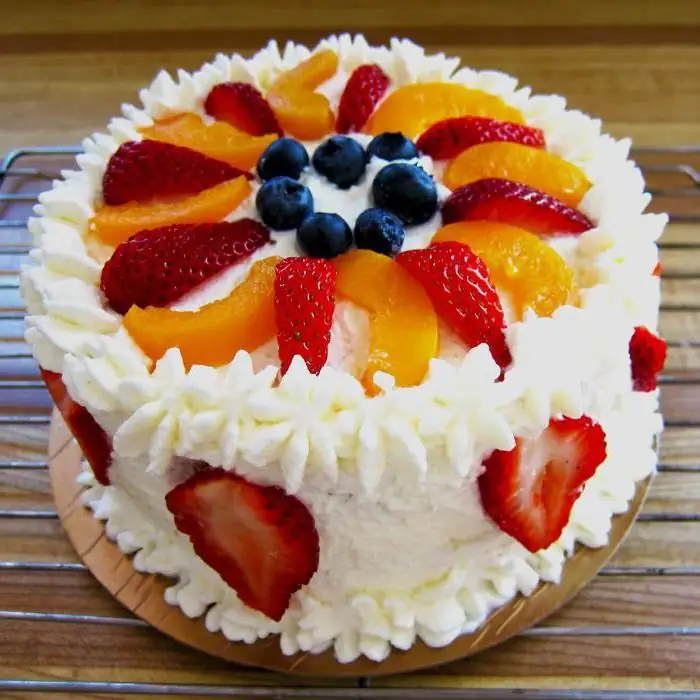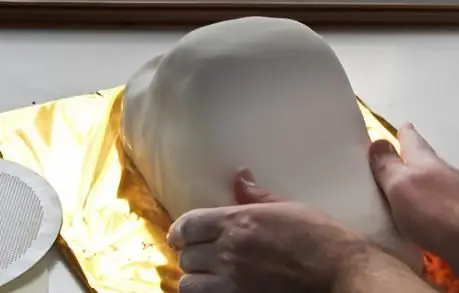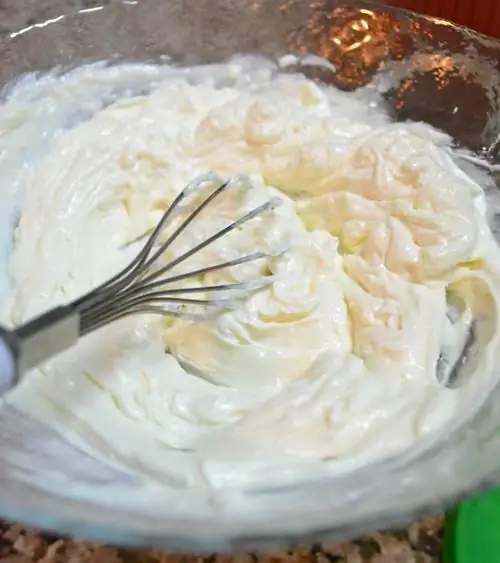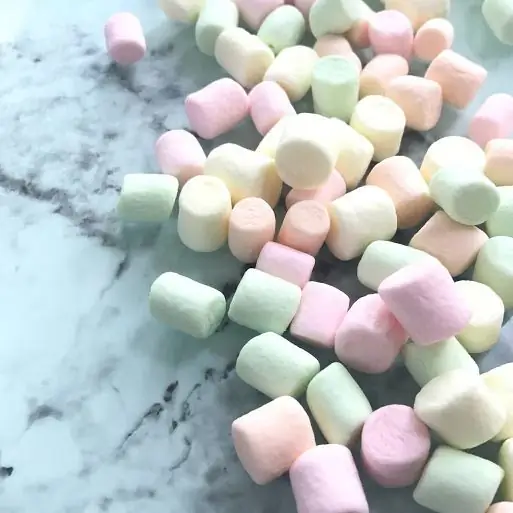2025 Author: Isabella Gilson | [email protected]. Last modified: 2025-01-23 12:50:39
Baking cakes at home is a hobby of many housewives. The use of mastic will help to significantly improve the appearance of the finished product. What is it and how to use it - read the article.
Fasting cake for wrapping: cooking method
Mastic is a sweet decorative material that allows you to decorate a confectionery product in an original and bright way. Ready-made mass is sold in stores, but self-made mastic for covering the cake will be the best. At home, when making pasta, you can adjust the taste of the paste and its consistency, and also be sure that it is made only from natural ingredients.

Marshmallow mastic
This paste is easy to work with as it rolls out easily and doesn't harden when wrapping the cake. Solid color marshmallows give a single color, and when using different marshmallows, you can achieve several shades without adding dyes.
Required:
- 100g marshmallows;
- 200g powdered sugar;
- 4 tsp milk;
- a small piece of butter.
Marshmallow is finely chopped and poured with milk. Next, you need to either heat the mixture in the microwave, or melt in a water bath. When the marshmallow begins to melt, butter is added to it. The soufflé can be removed from the heat when it is completely dissolved. Powdered sugar is added to the resulting workpiece in parts. The mass is constantly mixed. Readiness can be determined by its consistency - the best mastic for wrapping a cake should resemble elastic dough and not stick to your hands. The resulting mass can be stored in a cool place for up to 3 months.
Milk mastic
Easy and quick preparation of milk mastic for covering the cake. The recipe includes inexpensive ingredients, and no special cooking skills are required to create pasta. The finished mass tastes good - condensed milk makes the mastic look like toffee.

Required:
- 1 can of condensed milk;
- 200g powdered sugar;
- 200g milk powder;
- 2 tsp lemon juice.
Mixing powder, milk and lemon juice. Next, you need to add condensed milk in parts, while kneading the workpiece until it becomes dense. A ball is formed from the resulting homogeneous mass, sprinkled with powdered sugar and cooled in the refrigerator for 12 hours. Before starting work, the mastic should lie down at room temperature for half an hour. Suchthe blank can be stored for up to three months, provided that it is protected from drying out.
Honey mastic
A distinctive feature of this mastic is its softness. The finished mass does not crumble or crumble, and also helps to mask the external imperfections of the cake.
Required:
- 950g powdered sugar;
- 125 ml honey;
- 15g gelatin;
- 45 ml of water.
Pour gelatin with water and wait until it starts to swell. Then add honey to it and heat it all over low heat until the gelatin dissolves. The honey mixture is added to the powdered sugar, and then it all mixes well. If the spoon does not cope with the density of the mass, then it should be kneaded with your hands. The workpiece should lie in a plastic bag for 30 minutes before use.

Ready-made mastic for covering the cake can be stored for 3 months at room temperature, and up to a year in the freezer.
Gelatin based mastic
Gelatin mastic for a covering cake is considered universal, so if a blank remains after decorating the cake, then flowers or figurines can be molded from it. The sweet mass turns out to be very soft and easily rolled out in a thin layer, necessary for wrapping the product.
Required:
- 10g gelatin;
- 450g icing sugar;
- 1 tsp lemon juice;
- 4 tsp water.
Gelatin is soaked in water and then boiled over low heat until it dissolves in the liquid. blankStir occasionally and do not bring to a boil. Next, mix the icing sugar with gelatin and lemon juice. The mass is mixed until completely homogeneous, covered with cling film and put in the refrigerator for an hour. After that, you can begin to cover the product.
Cooked mastic for covering the cake is stored carefully packed in cling film or an airtight container. In the refrigerator, this is a period of up to 3 months, and in the freezer compartment - up to six months. Before cooking, the mastic must be taken out in advance so that it warms up to room temperature.
Coloring mastic

Homemade mastic is usually white or yellow. To give the finished product brighter shades, you can use the following options:
- In the process of kneading the workpiece, add dry or gel dye to it. It should be borne in mind that by painting all the mastic in one color, you will get a plain cake. If it is planned to make decorative figures from the prepared mass, then this coloring option will not work.
- Already ready-made mastic for covering the cake is painted in different colors by separating it from the total mass of pieces of the desired size. To do this, the tip of the toothpick is painted with a bright gel and colored dots or lines are applied to the workpiece. After that, the piece is thoroughly mixed so that the color is evenly distributed.
- To get a brighter shade, it is necessary to color the mastic after the cake has been covered with it. Gel dye is diluted witha few drops of vodka, and then applied to the product with a sponge.
If you do not want to buy artificial dyes, you can use natural products. Beetroot, pomegranate, cherry, carrot, cranberry, orange and blackberry give bright shades.
Cake cover: step by step instructions

- The surface of the cake should be made smooth, as any bulges, bumps or pits will be visible under the mastic. To give an even shape, coat the top and sides of the confectionery with a thin layer of cream, which will smooth out all the bumps. After applying it, the cake should be cooled in the refrigerator.
- The kitchen table is generously sprinkled with starch or powdered sugar, and then homemade mastic is laid out on it. To cover the cake, it must be rolled out with a rolling pin to a thickness of 5 mm.
- A layer of mastic is carefully transferred to the cake.
- It is necessary to smooth the rolled mastic: first from above, and then from the sides. When smoothing, you need to make sure that air bubbles do not form - this will spoil the appearance of the product.
- Excess mastic is cut off along the bottom edge of the cake.
If the close-fitting turned out to be not very neat, you can mask the flaws with decoration - cream inscriptions or voluminous figures.
Rules for working with homemade mastic
There are a few general rules to follow when wrapping the cake yourself with fondant:
- For the preparation of the mass, you should carefully choose the powder. In the presence oflarge sugar crystals skin-tight may break.
- Mastic is not applied to sour cream cream or excessively soaked cakes, as the coating may dissolve from contact with moisture.
- If the mastic for the covering cake has frozen and stopped rolling, then heating it in the microwave will help. After that, it will become plastic again.
- To give the cake a mirror shine, you need to grease the cover with a solution of vodka and lemon (1:1). The smell of alcohol will disappear from the product, and the glossy shine will remain.

Homemade mastic does not require a lot of money or time, because it is prepared from simple products. But now any cake can be turned into a small work of art that will delight loved ones and surprise guests.
Recommended:
How do they decorate cakes like plasticine? How to decorate a cake besides mastic? How to decorate a mastic cake on top in autumn?

Homemade cakes are much tastier, more fragrant and he althier than store-bought ones. At the same time, many are interested in how to decorate the cake on top. To date, there are a huge number of ways to decorate confectionery. Most of them are quite simple and can be easily done at home
Mastic - what is it? Mastic preparation. How to make mastic at home

Mastic decorations always evoke special delight among gourmets. What is not fashioned from it! And medieval castles, and noble frigates, and figurines of fabulous creatures. Let's see how this magnificence is done
Mastic from condensed milk. Milk mastic on condensed milk. Mastic with condensed milk - recipe

You can, of course, go to the store and buy ready-made cake decorations from marshmallows, glucose and glycerin. But, firstly, all these garlands, beads and bows with flowers do not bear a trace of your individuality and creative imagination, and secondly, they are not cheap. Therefore, today we will learn how to make mastic from condensed milk
Cake "Monomakh's Hat": recipe and cooking method

Today we will learn about a rather simple, but at the same time unusual and tasty cake "Monomakh's Hat". The recipe for this dish is very easy and will not take you much time, the ingredients for the cake are in almost every home
Marshmallow mastic cake: delicious recipes, cooking features and interesting ideas for decorating a cake

Today, cakes decorated with fondant are gaining more and more popularity among the sweet tooth. There are many ways to prepare it. One of the easiest options for making mastic is to create this product from marshmallows. What are the recipes for marshmallow fondant cakes? What is known about how they decorate? How to make mastic for marshmallow cake at home? What secrets of working with this material should home confectioners remember?

